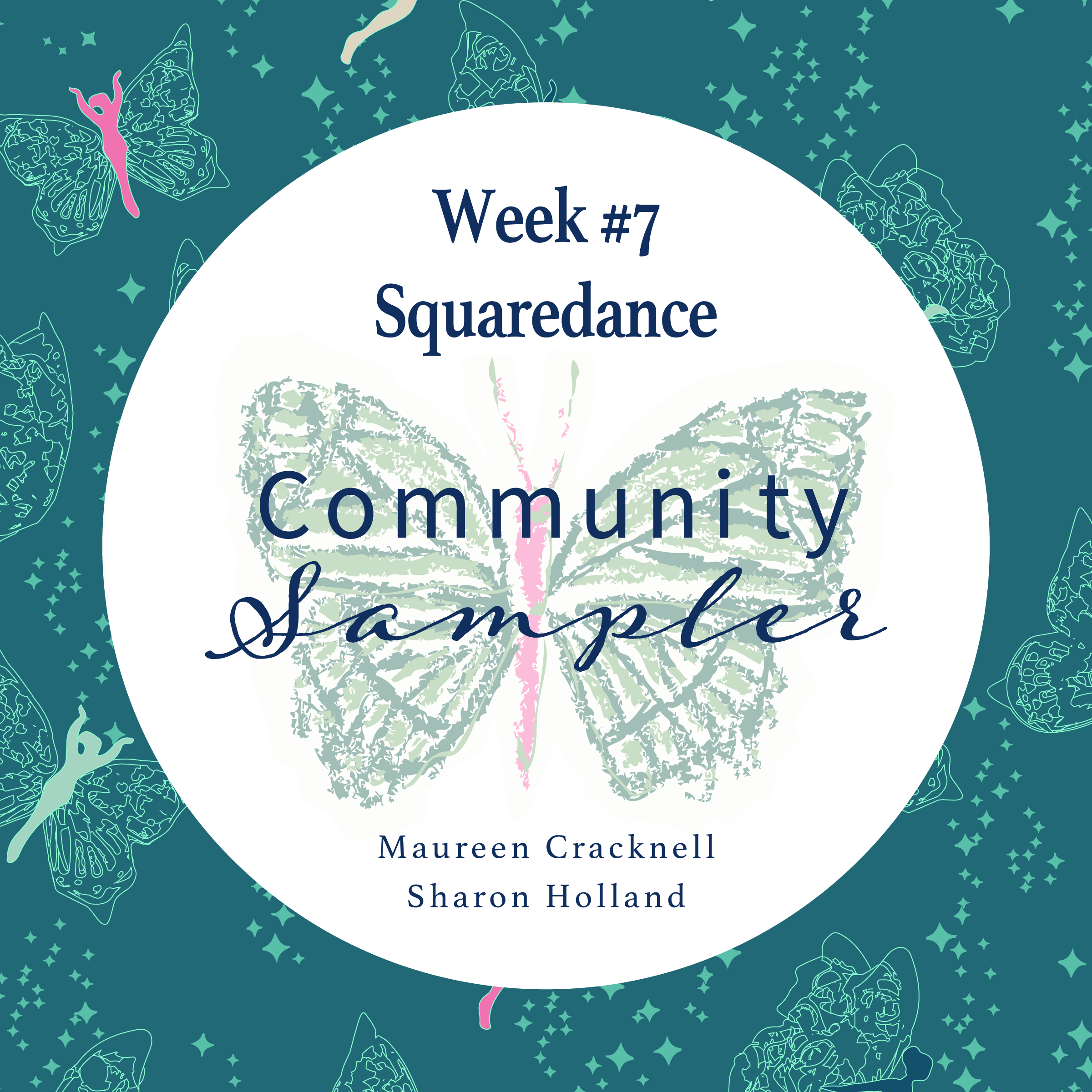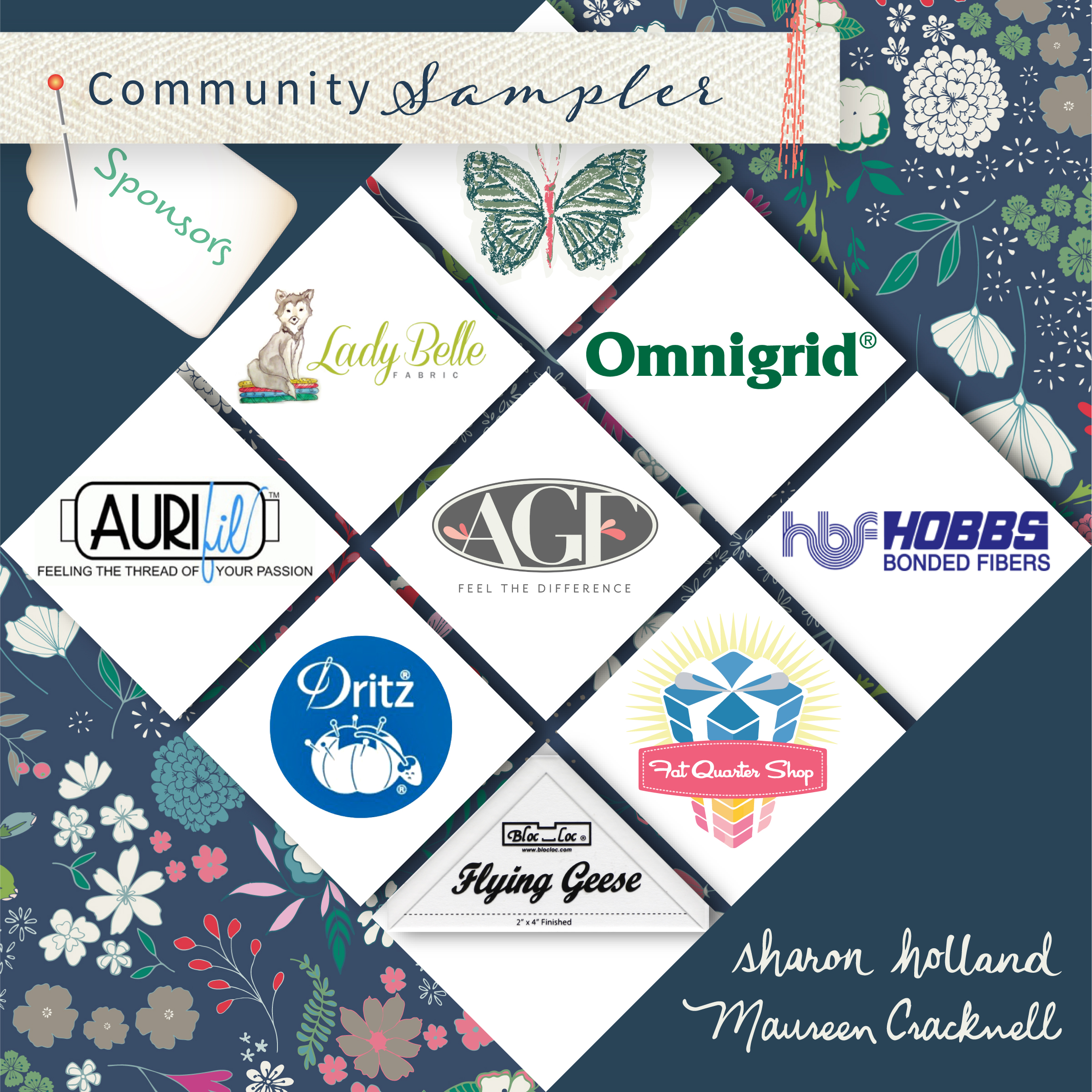Community Sampler Week #7
My co-host and sister Art Gallery Fabrics designer Maureen Cracknell and I are so happy to have you sewing with us on this block-of-the-week sew along.
It's April already and we're over halfway done with our blocks! There are eleven blocks in our quilt and each Wednesday will be a new PDF block release or finishing step for the quilt. If you are just joining us, pick up the Introduction PDF on the Sew Along page and you'll get a material list along with coloring pages so you can get started planning your quilt. Then, work your way through the first Community Sampler post to the present.
Many of the patchwork units (like Quick-Corner, Flying Geese, Half-Square Triangle, and Square-in-Square units) used in this year's sampler have already been oversized to allow for trimming and squaring of units before assembling your block. Please cut your pieces EXACTLY as given in each of the PDF instructions because bumping up the size of the pieces from the measurements give will not bring great results in some cases. Take advantage of my in-blog tutorials for each of the different quilting techniques used in our sampler.
Accurate cutting and use of a true 1/4'' seam allowance is a must for successful patchwork piecing. All your blocks will measure 12-1/2'' square (unfinished). Review how to cut strips, sew with a true 1/4'' seam allowance, and other helpful piecing tips on my "Are You Ready to Sew" post.
Let's start sewing the Squaredance block. Download the free PDF on the Sew Along page.
Our block this week is a relatively easy one that uses squares and Flying Geese units. If you need to review how to make No-Waste Flying Geese, revisit my tutorial from week #3. Also, you may want to review the directional fabric tutorial if you want to control the way your prints lay in your Flying Geese units.
There'll be no new tutorials this week but instead I will give cutting information for making block variations because I ended up turning this easy block into a big production.
Since I'm sewing my sampler in only solids, that large center square intimidated me and just felt too expansive. I knew this may be an issue for me when I was designing this quilt but felt that those wanting to showcase a large print would love this opportunity and space. I ended up making seven different versions of this block and who knows, I may still may end up making more by the time I have to set them into a top. I'm still not in love with my block but thank goodness it's an easy one.
Squaredance Block Variations
You can treat this block as your wild card block and really have some fun making it your own. An 8” finished square center (8-1/2” square unfinished) is basically a nice size for a block by itself. You can utilize any of the techniques we've learned so far to make an 8-1/2” unfinished block center (maybe even look back at the Sewcial Bee Sampler blocks), work on something completely new, or stick to the pattern and make it as written with a 8-1/2” cut center square.
Now, I think all the versions I did are pretty nice so don't get me wrong, there's not an option that's right or wrong or better than the other, it simply comes down to personal choice and what works in the quilt.
Variation 1
My first instinct to make that center square less intimidating (see block #1 in group photo) was to put a print in it. I used my Art Gallery Fabrics Tiny Dancer print from Sketchbook since it's a non-directional and organic print with colors went well with my solids in my quilt. But, with the rest of the quilt being all solids the print option just wasn't working for me and brought even more attention to that center square.
Blocks #2 and #3 are done like the pattern calls for as well but use solid fabrics for the center. I'm pretty sold on #3 and it's still in the running for making the final cut for the quilt. It was my original vision for this block and sometimes that turns out to be the best choice. That large solid center wasn't looking so bad after all and it was just a matter of the right balance of colors for me.
Variation 2
Block #4 uses four 4" finished Half-Square Triangle (HST) units to make up the 8" finished block center. You can review how to make HSTs from the last weeks Fairground block and use those exact measurements for cutting in Variation 2.
In my variation I cut:
- two 5" squares of peach
- one 5" square off-white
- one 5" square gold
I paired a peach square with each of the other colors to make a total of four HST units. I trimmed my units to 4-1/2" square before sewing them together into a Four-Patch center square that measured 8-1/2" square. I then used that pieced center square to take the place of 8-1/2" square in the instructions.
Variation 3
The Triple-Square Triangle units we made for the Ribbon Star block were just the right size once sewn together (Four-Patch style) to make an even more elaborate center for this block. Use the sizes given in that pattern and make four TST units.
Blocks #5 and #6 in the group photo show how I ended up making two different pieced-center blocks version. One with five different solid colors and another with four different solid colors. Just by switching the color placements and number of colors it created two very different looking blocks. This could be a neat block to explore in a quilt just of these blocks. I really love the gold and pinks block but it just wasn't right for my sampler.
My Block...for Now
I ended up selecting the HST Variation 2. I kept seeing a sunflower shape in this block with petals and a large seed head center. The golden solid for the petals and the darker center of this block makes this block shine.
Above are my Art Gallery Fabrics Pure Elements solids selections for this block served up on the perfect plate that Van Gogh would completely approve of this palette.
There's lots of ways to dress up this block if you wanted to. If you're thinking of adding embroidery be sure to oversize your square to at least 9-1/2” square to start. Center your design and leave a good 1'' around the edges for trimming to size and the necessary seam allowance. Do any handwork to the square before it's assembled into a block. Press it well and trim to 8-1/2” square then proceed as you would for making the block.
The same would go if you're doing improv piecing, or creating a label on this center square. Start larger than needed and trim to the required size. Don't forget to put your design on-point as the block will be set on-point once sewn together in the quilt top.
Thank you for making this sew along so special I love seeing all the blocks being posted and can't wait to see what you do with this wild card block. Please visit Maureen's blog and see the progress she's making on her sampler quilt, using her beautiful AGF fabrics Love Story collection. Be sure to use the #CommunitySampler hashtag when posting your blocks to Instagram and tag both my @sharonhollanddesigns and @maureencracknell so we don't miss any of your beautiful work!
COMMUNITY SAMPLER SPONSORS
Don't forget that this Friday's a Giveaway Friday on the Community Sampler sew along. Maureen and I will take turns hosting a giveaway each week where one of our generous sponsors will be featured and offering amazing prizes both here on our blogs and also on Instagram. Maureen will be hosting the giveaway this Friday and you'll be instructed how to enter at that time.
Flight Quilt
On a side note, I've just published the PDF pattern for my Flight quilt first seen in Modern Patchwork magazine March/April 2017 issue. I had to wait a year for it to be out of contract before I could publish it as a stand alone pattern but it's now available on my Craftsy pattern page.
Photo courtesy of All People Quilt
This fun and easy quilt design was pieced with all Art Gallery Fabrics Pure Elements solid fabrics. The design for the quilt was inspired by a floating staircase and I used some color theory and artsy tricks for fabric placements.
First I wanted to create the illusion of depth so I placed the vibrate saturated colors in the foreground (bottom of the staircase, closest to the viewer) and used muted, dustier tones at the top of the stairs to make them appear further away. That's the same way you create depth in landscape paintings.
By separating the diagonal sides of the quilt into light and shade it was not only another excuse to use another fabric color but again added weight and a light and shadow effect to the design.
This quilt is a departure for me but I had a lot of fun with it and is one of the three all solids quilts I mentioned at the beginning of the Community Sampler sew along. I've not worked with solids exclusively very often but each time I have it's always turned out well.
View all my patterns for sale on my Pattern page. They are all available on Craftsy and selected patterns are available at Connecting Threads and UpCrafts Club.










